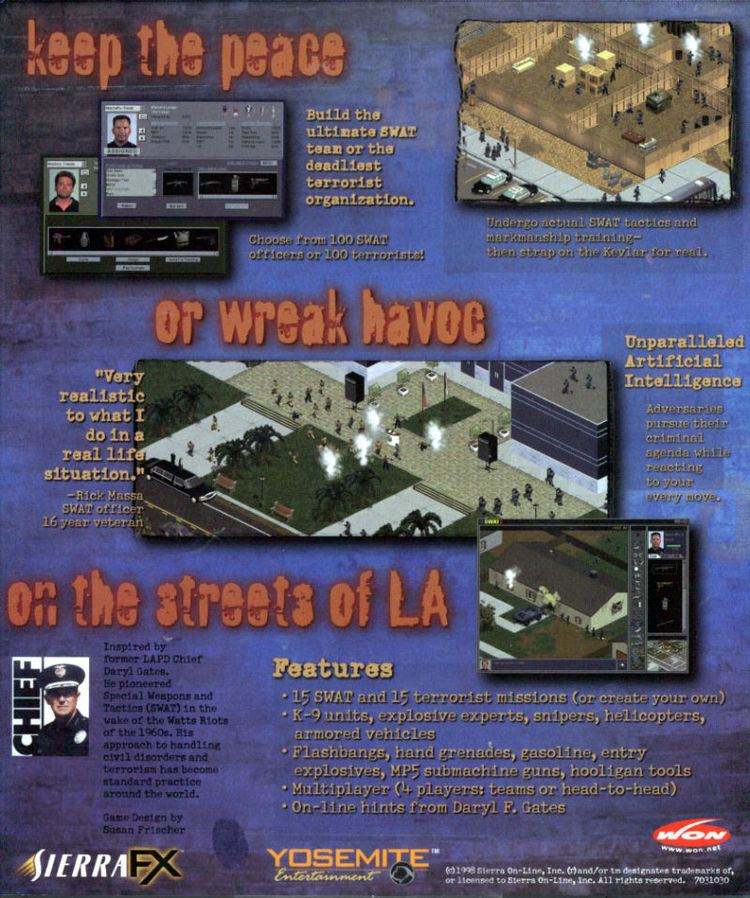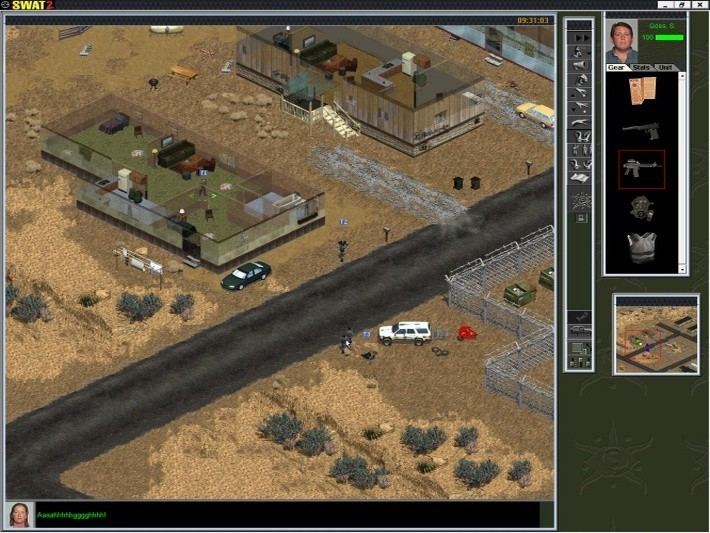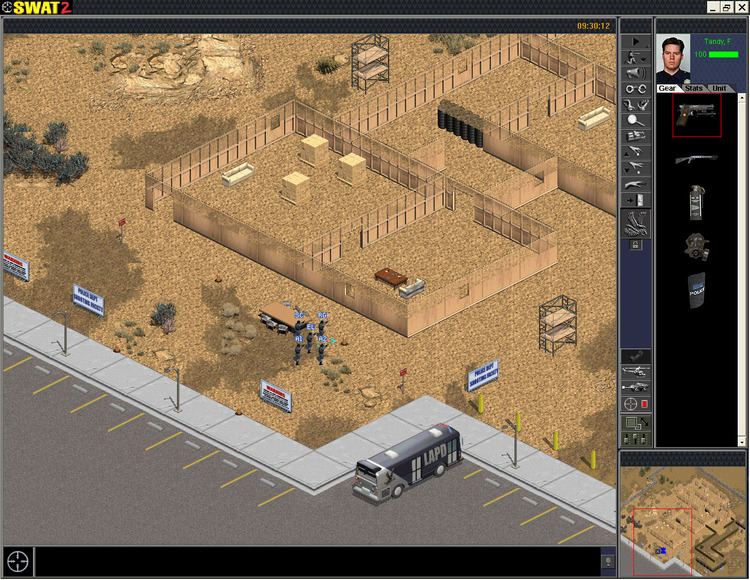5.8 /10 1 Votes
Producer(s) Oliver Brelsford Programmer(s) Victor Sadauskas Initial release date 1998 Genre Real-time tactics | 5.7/10 GameSpot Designer(s) Susan Frischer Writer(s) Susan Frischer Publisher Sierra Entertainment | |||||||||||||||||||||||||||||||||
 | ||||||||||||||||||||||||||||||||||
Composer(s) Jason HayesChance Thomas Developers Sierra Entertainment, Yosemite Entertainment Similar Police Quest games, Sierra Entertainment games, Strategy video games | ||||||||||||||||||||||||||||||||||
Let s play police quest swat2 swat campaign part 1
Police Quest: SWAT 2 (stylized as SWAT2) is a 1998 real-time tactics and police simulation video game released for Microsoft Windows. It is the sixth game in the Police Quest series. It uses an isometric projection camera view, somewhat similar to the squad-level real-time tactics video game in the mold of X-COM or Jagged Alliance games. Police Quest: SWAT 2's gameplay takes place in real-time, with the player issuing orders to individual avatars from a static isometric view of the level.
Contents
- Let s play police quest swat2 swat campaign part 1
- Development
- Plot
- Gameplay
- Marketing
- Reception
- References

Development
Many of Police Quest: SWAT 2's in-game missions were based on real life events, such as the North Hollywood shootout of February 1997, and a small-scale riot at a strip mall that can be seen as a parallel to the 1992 Los Angeles riots that followed the Rodney King beating incident. The game's soundtrack was composed by Jason Hayes and Chance Thomas, with the game's theme song being titled "Just Another Day in L.A.", performed by Utahn singer Randall "Randy" Porter, composed by Chance Thomas, and written by Susan Frischer. The lead designer was Susan Frischer.
Plot

Police Quest: SWAT 2's story takes place in Los Angeles, California and the surrounding metropolitan area in the game's then-future of 1999, and revolves around a fictional conflict between the Los Angeles Police Department and a fictional emerging left-wing domestic terrorist organization calling themselves the "Five Eyes", led by a mysterious figure named Basho, and his second-in-command, Dante.

As a homage, Sonny Bonds, the protagonist of the original Police Quest series, is one of the LAPD SWAT officers available for the player to send into missions during the LAPD SWAT campaign. Sonny's high initial stats, some of the best in the game, allow him to become certified as an element leader.
Gameplay

The game features two separate campaigns, one in which the player controls SWAT and another in which the player takes the role of a lieutenant in the Five Eyes terrorist organization.
The player assumes the role of police chief John De Souza, and direct control of the SWAT Elements on the mission map. The player receives information about the mission from crisis negotiator Sgt. Michael Alvarez. At the end of a mission, the player is debriefed by Sgt. Griffin Markossian. While playing as SWAT, the player must adhere to certain rules and regulations, such as refraining from opening fire on non-threatening subjects and avoiding friendly fire. Failure to obey regulations may lead to officers getting suspended or terminated, or the game may even end as the police chief himself is fired. Officers who kill a suspect legally are always suspended for at least one mission as the shooting is investigated while the player earns fewer points than if the suspect was arrested, which affects the amount of money budgeted to SWAT. Therefore, it is in the player's best interests to capture rather than kill suspects.
The Five Eyes is controlled by Basho, a high-ranking officer in the Council of the Five Eyes. Basho provides all briefings via a TV screen. Basho’s right-hand man is Dante, a self-proclaimed Bellwether of the Second Order. As a terrorist there’s no specific persona the player assumes. Instead, they merely control all terrorist units during a mission.
The gameplay in the Five Eyes scenario is slightly different. Most prominently, additional members can be recruited from hostages, and gunning down police and other armed individuals who may not necessarily present an immediate threat is encouraged and rewarded. Killing hostages is still penalized (Basho wishes to recruit rather than kill them) but to a much lesser extent than in the SWAT campaign. Only the killing of certain special civilians will lead to an early end of the game. Terrorists can be arrested by the police, but they will eventually manage to make bail and then skip town to rejoin the Five Eyes. Therefore, it is sometimes to the player's advantage to allow one of his terrorists to be arrested in order to save their life and slow down the SWAT team.
The weapons are also different, but still have the same purpose, such as the terrorists' primary automatic weapon being the LR 300 instead of SWAT's MP5A2.
There are 30 missions in total, fifteen each for SWAT players and for the Five Eyes scenario. They are independent storylines and neither affects the game of the other, though some settings and events are common to both campaigns. Both scenarios can be played from the start of the game, simply by selecting the option at the New Solo Game interface window.
The terrorist missions have a similar interface, with a few added options related to hostages but much fewer tactical actions, and the basic premise is comparable. Notably, a terrorist mission ends when all police are killed. This may or may not be desirable, depending on how many mission objectives have been completed.
The first two missions in both scenarios are training missions. Subsequent missions greatly impact the budget (see above), and outright failure in certain missions may end the campaign altogether.
While not a true adventure game, it does contain an inventory and menu options similar to other Sierra adventure games and previous Police Quest titles (a 'look/search' icon, a pick-up hand icon, a talk/challenge/communication icon, etc.). On occasion there are items such as a 'pizza', 'throw phones' or 'evidence', that must be picked up and used to solve ingame puzzles. Unlike most strategy games, there are many cases where the player must 'communicate' and speak with the enemy side (either with a "throw phone" or an existing telephone), and convince them to stand down, release hostages, draw them into the open or simply buy time. SWAT also has access to an armored car and a helicopter which the player can call in through the interface, while a terrorist player can call in a getaway car. The availability of these vehicles depends on the mission.
Marketing
Police Quest: SWAT 2 was later re-released in the "SWAT Career Pack" (with all six Police Quest games), the Police Quest: SWAT Force pack (which included the first two SWAT games), the Police Quest: SWAT Generation collection (with SWAT and SWAT 3), and in the Police Quest: SWAT 1 & 2 at GOG.com. Early releases of the game were listed as Police Quest 6 (PQ6) in the file names and folders. However, that name does not appear on the title screen or cover art.
Reception
With much more positive reviews than the previous two games, Police Quest: SWAT 2 still had several flaws, such as the overly complicated interface, micromanaging, an imperfect artificial intelligence, and a simple work-around of selling the sidearms of unused avatars that allowed players to ignore the budgeting and financial aspect of the game.
